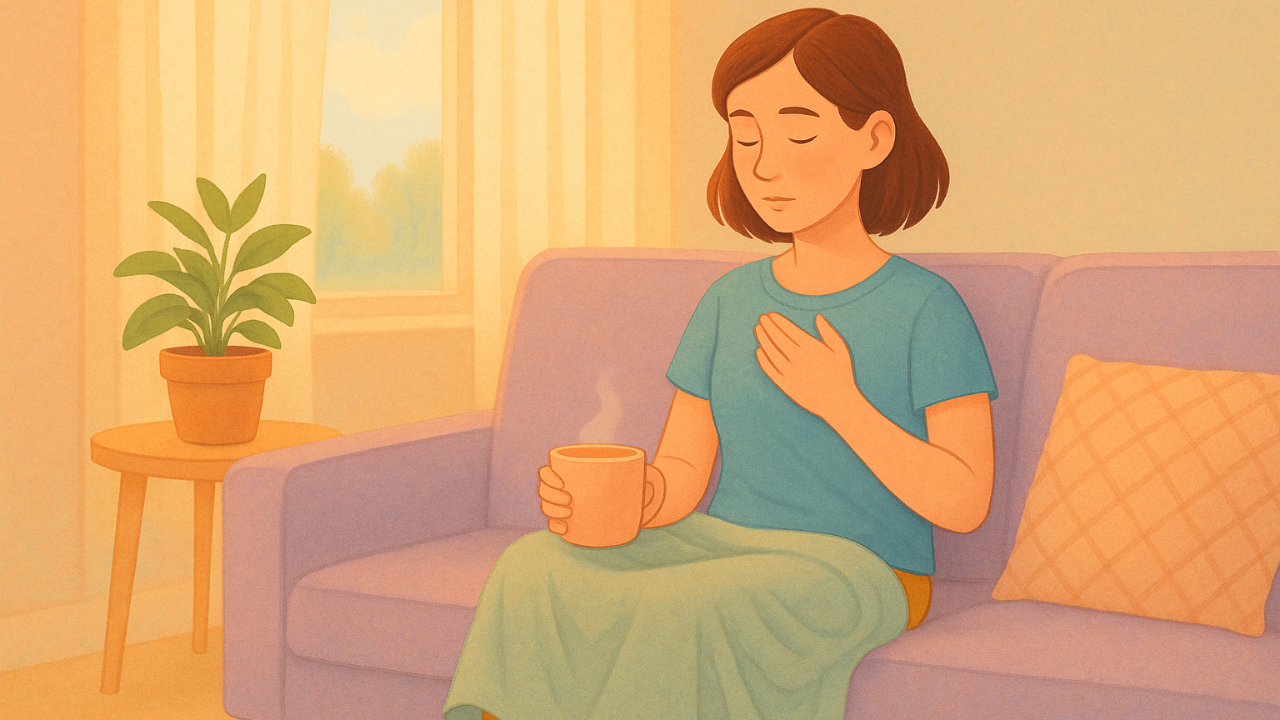
Feeling Your Body Again After Numbness
When numbness shows up, it can feel like your body went quiet. Sensations feel muted. Emotions feel far away. You may feel like you’re watching yourself from the outside instead of living inside your skin.
If this is happening, you’re not doing anything wrong. You’re not broken. Many people who experience chronic stress, shutdown, or dissociation feel exactly this way. Your system may simply be overwhelmed and trying to protect you, similar to what I describe in Why Your Body Goes Numb During Stress.
Below is a gentle way to come back into your body slowly and safely.
A Simple Explanation of What’s Happening
Numbness often shows up when the body feels like “too much is happening.” Instead of sounding the alarm loudly, it goes in the opposite direction and turns the volume down on sensation. This is part of the freeze or dorsal vagal pattern.
Some people feel the opposite, a jumpy kind of hyperalertness, like what’s described in
Why do I always feel ready to jump out of my skin for no reason?
Others feel both states, switching between numbness and panic, which can be confusing. If you experience that mix, you might relate to What Are Panic Attacks? Why Do They Happen? Can I Stop Them?
Numbness is not a failure. It is your system asking for slowness.
Start With Tiny Sensory Cues
When you’re numb, big grounding tools can feel like too much. Small is better.
Temperature cues
- Hold a warm mug.
- Touch a cool surface like a countertop.
- Run water over your hands for five seconds.
Temperature often sneaks through first when other sensations don’t.
Slow, tolerable touch
Try something that feels calming, not activating.
- Press your palms together.
- Rest your hand on your chest.
- Cup your face lightly.
Gentle touch activates safety pathways in the body, similar to the principles in What is Trauma Informed Care?
Feel one tiny anchor point
Instead of “feeling your whole body,” which is too big, choose one small area.
The pads of your fingers.
The weight of your feet.
The texture of your sleeve.
Your job is simply to notice one sensation, even if it is faint.
Movement Helps Break the Freeze Pattern
Numbness often softens when your muscles begin to move gently.
Nothing big. Nothing forced.
Try:
- Rocking slowly side to side.
- Turning your head left and right.
- Standing up and sitting back down.
- A tiny shoulder roll.
Movement reintroduces proprioception, which is the body’s positional awareness. This is the same principle behind somatic tools like pendulation and gentle shaking found in many nervous system practices.
If you tend to go numb after panic or overwhelm, you may appreciate this gentle guide:
Grounding During Panic Without Talk Therapy.
A Micro Practice: “30-Second Reentry”
Try this anytime numbness feels heavy:
-
Sit or lie somewhere you feel reasonably okay.
-
Place one hand over your heart or upper chest.
-
Place the other hand over your belly or thigh.
-
Notice temperature, pressure, or texture.
-
Count three natural breaths without changing them.
If your mind wanders or you can’t feel anything yet, that’s not failure. Your system is simply pacing itself.
If focusing on breath feels uncomfortable, you are not alone. Many people find slow breathing actually increases their anxiety, as described in Why Deep Breathing Makes Me More Anxious, And What To Do Instead
In that case, stay with touch or temperature instead.
If You Feel More Wired Than Numb
Sometimes numbness isn’t stillness. It’s overwhelm that collapsed.
If your belly feels fluttery or hollow, you may relate to Butterflies In Your Stomach: Trauma Or Anxiety?If this is you, try grounding that includes weight or pressure:
- A heavier blanket.
- Leaning your back into a wall.
- Pressing your feet firmly into the floor.
Wired numbness often needs “containment,” not stimulation.
A Gentle 7-Day Reconnection Plan
Day 1: Warm water over hands for 20 seconds.
Day 2: Sit against a wall and feel the contact on your spine.
Day 3: Two-minute slow walk. Focus on feet.
Day 4: Touch something textured. Describe it.
Day 5: Gentle self-touch on arms or hands.
Day 6: Breath counting or simple orienting.
Day 7: Choose one of the above and repeat it twice.
Your system learns through repetition, not force.
Common Sticking Points
“I still feel nothing.”
This is common. Use temperature. It’s usually the first sense to return.
“It feels scary to feel again.”
Go slower. Keep practices under 30 seconds. Open your eyes. Sit somewhere familiar.
“I start feeling and then drift out again.”
This might be a sign your window of tolerance is small right now. That’s not wrong. Slow, consistent work widens it over time, as explained in the trauma-aware approach within Building Resilience To Withstand The Storms of Stress.
“I get emotional when sensation returns.”
This is normal. Your system may be releasing tension as it softens. Pause and breathe naturally.
If numbness is chronic, painful, or affects daily life, consider talking with a qualified professional who can support you.
More Gentle Reads
Here are three companion pieces you may find soothing:
- Shutdown Response vs Burnout: How to Tell the Difference
- Pendulation: A Simple Somatic Exercise to Calm Your Nervous System
- Grounding Techniques for Dissociation That Actually Work
Disclaimer: This article is educational and not medical advice. It cannot diagnose, treat, or cure any condition. If numbness, dissociation, or physical symptoms are intense, persistent, or interfering with daily life, consider speaking with a qualified healthcare or mental health professional for support tailored to your needs.
Discover Your Vagal Tone
Find out how dysregulated your nervous system is and get your personalized roadmap to feeling calm, energized, and in control


